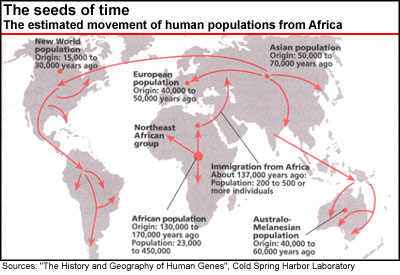The magnificent 500
 geneticists who gathered at a conference on human evolution in October at the Cold Spring Harbor Laboratory, New York, have come out with some estimates that could change our understanding of the evolution of our species. They say that as few as 500 individuals, who moved out of Africa some 1,40,000 years ago, may have populated the rest of the world. The estimates have been derived from a new kind of archaeology which depends on the human genome.
geneticists who gathered at a conference on human evolution in October at the Cold Spring Harbor Laboratory, New York, have come out with some estimates that could change our understanding of the evolution of our species. They say that as few as 500 individuals, who moved out of Africa some 1,40,000 years ago, may have populated the rest of the world. The estimates have been derived from a new kind of archaeology which depends on the human genome.
The estimates will only be accepted when historians and archaeologists can finds dates and numbers to match. But the estimates establish dna as a vast resource for information on human evolution. Due to the fast methods of dna sequencing and reading of chemical letters, geneticists are gathering an immense amount of data regarding human populations. But work on developing methods to interpret this data is still in the initial stage. Estimates of the size and location of human populations and the timing of their migration from Africa were also discussed.
But the calculations of the geneticists are based on a number of assumptions, and their dates have large margins of error. This created a lot of confusion for those participants at the conference who came from other disciplines
Related Content
- Ottawa confirmed as the biodiversity hotspot for a subfamily of wasps in North America
- Human-elephant conflict mitigation measures: lessons from Bangladesh
- Tibetan crane's winter habitat under threat from Indian hydroelectric project
- Sand mining threatens heritage
- Greenland Meltwater Contributes to Rising Sea Levels
- Rara national climate change conference concludes with nine-point declaration
